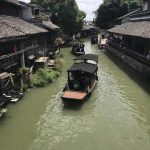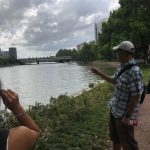Blog Entry Written by Team: Finless Porpoise
Team Members: Yanling Wang (Queen’s), Shidan Wen(BNU), Renata Sampaio (Laurier)
Weather: Partly Cloudy, Temp 33ºC
Day 1!
Today we had our first expedition to visit the Wuzhen water village. Along our way to the village, we saw beautiful Chinese architecture and saw the Jinghang Grand Canal. The Grand Canal was built thousands of years ago to connect South and North which allows fast transportation of goods in ancient China. Although it serves an important role in transportation, it brings some ecological problems such as introducing invasive species and constantly removing sediments. The Grand Canal is a great example of human taking advantage of vast water network. After passing by the Grand Canal, we also saw a power station that is powered by burning fossil fuels. In order to protect the environment, the government have cut down coal burning in the past decades, especially in populated area. Nowadays, the Jinghang Grand Canal aids in the transportation of water from the South of China to the North, where a shortage occurs.
We made it to the water village and after a few pictures with the locals, ventured inside. We divided into small groups to tackle the beautiful village. Wuzhen village was built on water networks. The water network within the village allows the people who live there, access for transportation, laundry, and a sewage system. It has become a very popular tourist attraction due to its unique design. The traditional buildings in the village have black roof tiles and white walls. To aid with ventilation, people built their house with gaps in the roof thus air can pass through easily. The river running through the village seems to be polluted by human. The water was turbid and appears to have a lot of algae due to rich nutrition from human activities. Other pollutants are heavy metals and human litters. Within this village there were many museums, a school, a temple and lots of local cuisine to choose from. YUM! We were all happy to be back on the fresh, cool bus after being outside in the hot sun and on our way for lunch. We tracked through a local kitchen and after a few twists and turns made it to our table at Grandma’s Kitchen. The food was scrumptious!
Once we arrived at the hotel we had some time to relax and freshen up. We spent the evening working on our group projects, giving formal introductions and having a discussion with the professors about the impacts human development has had on the water resource in China. Overall it was a wonderful and enlightening day and we are excited for what the rest of the week has to offer!
第一天!
今天我们前往乌镇水乡参观。一路上,我们目睹了中国建筑的美丽和京杭大运河的壮阔。京杭大运河从开凿到现在已有两千多年的历史,对中国南北地区之间的运输起着重要作用。但在提供交通便利的同时,它也带来了一些生态问题。船舶持续在航道航行可能会导致生物入侵。同时,为了保持航道深度,河底沉积物在不断被清除。京杭大运河是人类利用广阔水网的一个典型例子。路过大运河后,我们还看到了一个发电站,它的能源主要来自于化石燃料的燃烧。在过去的几十年里,为了保护环境,政府关闭了许多煤电厂,特别是在人口稠密地区。如今,京杭大运河还被纳入中国的“南水北调”工程,以利于实现中国水资源的南北调配。
我们进入乌镇水乡,与当地人合影留念。我们分成小组,沿不同的路线探索乌镇水乡。乌镇水乡坐落于江南水网平原,居民的交通、生活用水以及污水排放都依赖于这条贯穿水乡的河流。青瓦白墙,古色古香,乌镇如今已经成为一个著名的旅游景点。乌镇的建筑设计十分特别,两层房顶之间的间隔增强了屋内通风,帮助人们度过湿热的夏天。河水碧绿而浑浊,这样“美丽”的色彩来自河水中泛滥的藻类,是人类活动造成水体富营养化导致了这一现象。另外,水体还存在重金属污染和许多人类垃圾。在小镇里,我们踏着青石板路,参观了许多博物馆、学校和寺庙,沿途还有许多当地美食可供选择。
一顿丰盛的午餐缓解了旅途劳顿。我们来到当地正宗的餐馆“外婆小灶”共进午餐,这里的食物当真是极好的!!
一天的旅程结束,我们回到住处稍加整顿。晚上,在进行了正式的自我介绍之后,我们与教授们分享了今日见闻,讨论了中国人类活动对水资源的影响。
跟大家一起度过了如此美妙的一天,让我们对接下来的旅程充满期待!
- Canal-side windows at Wuzhen Water Village
- Tourist boats in the canal running through Wuzhen
- Professorial selfie – Yuxiang, Steve & Bojian
- Power station en route
- Polluted turbid water in village
- Jinghang Grand Canal
- Doing laundry in the canal at the village
- Another view of architecture from canal side








Leave a Reply